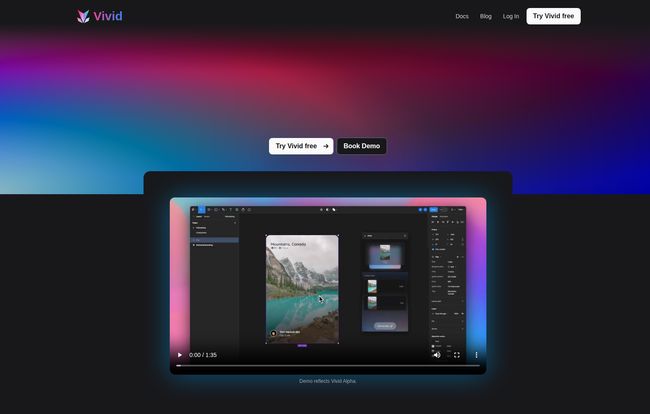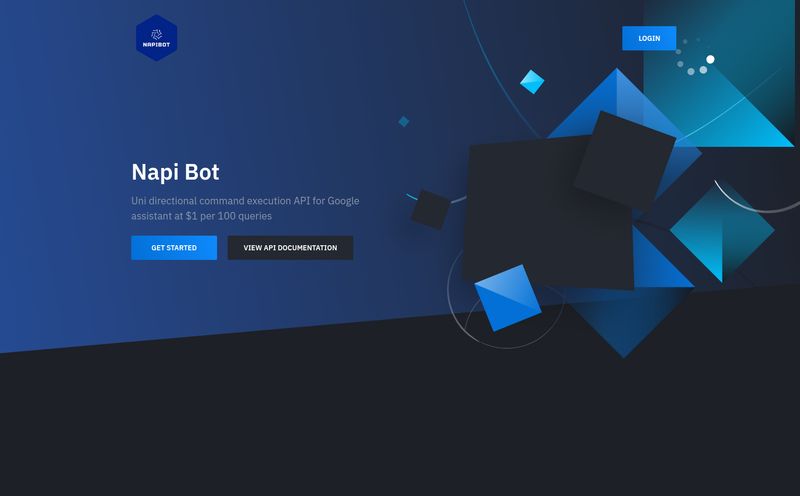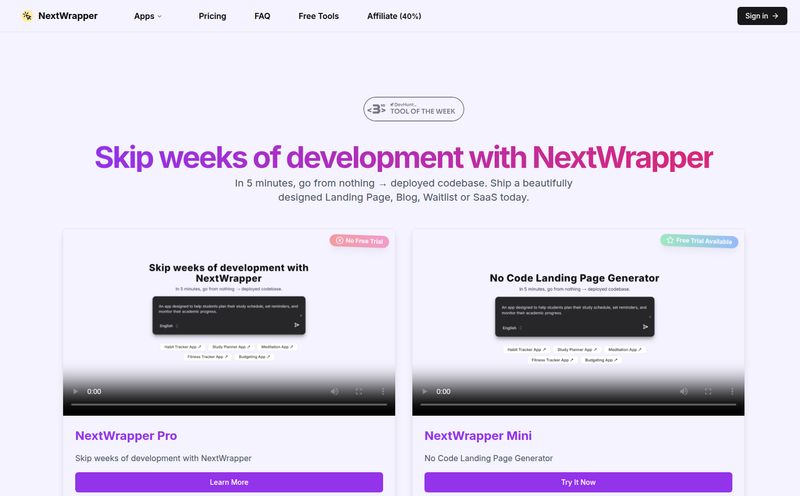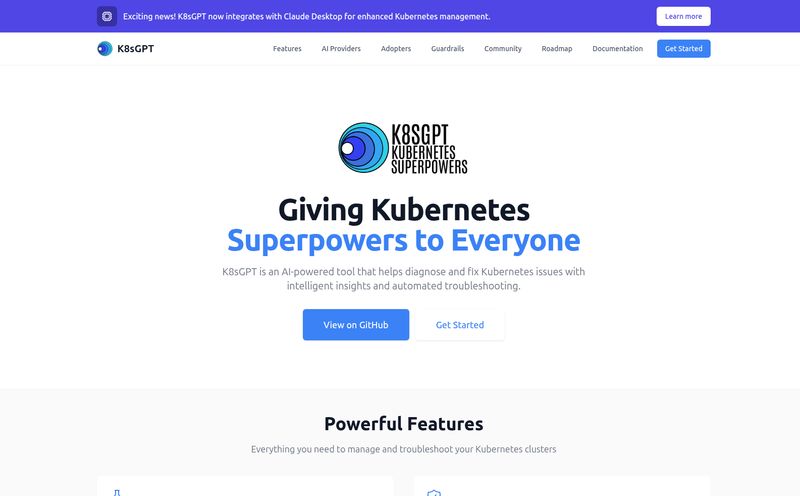For years, it’s been the stuff of legends, memes, and a whole lot of late-night Slack messages. The “Can you nudge this 1px to the left?” requests. The perfectly crafted Figma file that somehow explodes into a jumble of divs in production. It’s a game of telephone played with pixels and code, and frankly, I'm a little tired of it.
So, whenever a new tool pops up claiming it has the solution, my inner cynic raises an eyebrow. I’ve seen a dozen platforms promise to magically turn designs into pristine, production-ready code. Most of them... don't. But then I stumbled upon Vivid, and I have to admit, my curiosity got the better of me. It’s not just another converter; it’s proposing a different kind of workflow. One where AI doesn't just do a one-time export, but lives within your development process.
But does it live up to the hype? Let's get into it.
So, What Exactly is Vivid? (And Why Should I Care?)
Okay, let’s cut through the marketing fluff. Vivid is an AI-powered tool that watches what you do and generates front-end code for it. The main hook is its deep integration with Figma. The idea is simple but powerful: it connects your design files directly to your codebase.
Imagine your designer polishes a button in Figma. Instead of you, the developer, meticulously translating every shadow, border-radius, and font weight into CSS, Vivid generates the updated UI code for you. It’s like having a hyper-focused junior dev who does nothing but perfectly transcribe visual styles into React components. The flow they show is simple: you interact with something, it generates the code, and it all syncs up between Figma and your code editor. Simple, right?

Visit Vivid
This is a big deal for traffic generation and fast iteration. The quicker you can get from a design concept to a live component, the faster you can test, learn, and improve your user experience. This isn't just about saving a few minutes on CSS; it's about fundamentally speeding up the entire development cycle.
My Favorite Vivid Features (The Stuff That Actually Matters)
A tool is only as good as its features, but I don’t care about a long list. I care about what actually solves a problem. Here’s what stood out to me.
Killing Boilerplate One Component at a Time
I don't know a single front-end developer who enjoys writing boilerplate. Setting up the basic structure of a component, hooking up the styles... it’s the digital equivalent of digging a ditch. It has to be done, but it’s not the creative, problem-solving work we love.
Vivid's AI code generation aims to eliminate this. Looking at the code snippets on their site, it’s not just spitting out disconnected CSS. It’s generating a whole React component, props and all. If this works as advertised, it could free up a massive chunk of a developer’s time to focus on what actually matters: state management, API calls, and complex business logic. The hard stuff.
The Figma Sync: A True Two-Way Street?
This is the holy grail, isn't it? A world where designers can truly own the look and feel of the product, right in production. Vivid’s promise to sync Figma with your codebase is its boldest claim. The idea that a product designer can tweak a color palette or adjust spacing in their native tool, and have that change reflected in the source code without a developer’s intervention... that's a workflow revolution.
Of course, the real question is how robust this is. I’ve seen similar systems become a tangled mess of overrides and !important tags. But if Vivid can maintain a clean, direct line from design token to production style, it could genuinely transform how product teams collaborate.
Editing in the Browser is a Neat Trick
Every front-end dev knows this dance. You open DevTools, you tweak CSS properties until everything is pixel-perfect, and then you painstakingly copy-paste those changes back into your SCSS or CSS-in-JS file. It works, but it feels clunky.
Vivid lets you make those edits directly in the browser and automatically syncs them back to the source code. It’s a small quality-of-life improvement that adds up. It closes a loop that has been open for, well, as long as I can remember.
Let's Be Real: The Good, The Bad, and The "Alpha"
No tool is perfect, especially one that's pushing the boundaries. After looking through their materials and thinking about my own experiences, here’s my breakdown.
First off, the sheer time saved on boilerplate is a huge win. Think of all those hours spent setting up basic component shells and styles... poof. Gone. Then there’s the designer empowerment angle, which is genuinely interesting. Giving designers a direct line to the production UI could smooth out so many review cycles and reduce that classic "it doesn't look like the mockup" feedback. It lets developers focus on function, while designers ensure the form is perfect.
Now, let's not get carried away. A big caveat I noticed is that the demo is for "Vivid Alpha." This tells me it’s still very much in development. Which is fine! But it means you should expect some rough edges. The biggest challenge I see, and this is true for ALL tools in this space, is the dependency on a well-structured Figma file. You can’t just throw a messy, ungrouped design at it and expect clean code. Garbage in, garbage out. Teams that already have a disciplined design system with proper auto-layouts and components will see the most success. For complex, custom functionality, you'll almost certainly need to go in and adjust the generated code. Think of Vivid as an expert starter, not a one-click finisher.
What's the Damage? A Look at Vivid's Pricing
This is the part of the review where I'd normally break down the pricing tiers. But here’s the thing… I couldn't. I clicked on their pricing link, and I was greeted with a friendly 404 "No page could be found" error.
Honestly? This doesn't surprise me. For a tool this new (still in Alpha, remember?), they're likely not ready for public, self-serve pricing. My guess is they're operating on a "Book a Demo" model, targeting teams and enterprises for custom-tailored plans. So, if you're interested, your only path forward right now is to reach out to them directly.
Who is This Tool Actually For?
So, should you drop everything and book a demo? It depends.
I believe Vivid is a fantastic fit for fast-moving product teams and startups who need to ship UIs quickly. If you're building an MVP or constantly iterating on new features, the speed boost could be a competitive advantage. It's also potentially a dream tool for teams building out a design system.
Who is it not for? If you're working on a massive, ancient codebase with a ton of technical debt, trying to shoehorn Vivid into your workflow might be more trouble than its worth. It seems best suited for modern React codebases and teams willing to enforce a bit of discipline on the design side. If you need absolute, granular control over every single line of hand-written code, this might feel a bit like giving up the wheel.
My Final Verdict on Vivid
So, is Vivid the messiah of the design-to-dev workflow? No, and it's not trying to be. It's not a developer replacement. It's an accelerator. A very, very smart one.
I’m genuinely optimistic about tools like Vivid. They represent a shift in how we think about building interfaces. They treat the design file not as a static blueprint, but as a living part of the development process. The success of this tool will hinge on a team's willingness to embrace both a clean design process in Figma and the idea of AI-assisted coding.
It's not magic. But it might be the closest thing we have to a real-world cheat code for front-end development right now.
Frequently Asked Questions about Vivid
- Does Vivid replace front-end developers?
- Absolutely not. It’s a tool to make developers more efficient. It handles the repetitive, tedious parts of UI coding, freeing up developers to solve more complex problems that AI can't touch.
- What frameworks does Vivid support?
- The examples on their website clearly show React code being generated. You'd have to check their official documentation or book a demo to see if they have support for other frameworks like Vue, Svelte, or Angular.
- How much does Vivid cost?
- As of now, the pricing isn't public. The pricing page on their website is down, which suggests you'll need to contact them for a demo and a custom quote.
- Do I need to be a Figma expert to use Vivid?
- You don't need to be a Figma god, but your designs need to be clean and well-structured. This means using components, auto-layout, and proper naming conventions. A messy design will likely lead to messy code.
- Can I edit the code that Vivid generates?
- Yes, and you should. The generated code is a starting point. The expectation is that developers will take it, integrate it, and build upon it with business logic and any necessary refinements.
Conclusion
Vivid is a fascinating and promising entry into the world of AI-powered development tools. It correctly identifies one of the biggest bottlenecks in modern product development—the gap between design and code—and offers a compelling solution. While it's still early days (hello, Alpha tag), it's a powerful demonstration of a more integrated and efficient future. If you’re on a team that’s constantly battling the handoff process, I'd say give the free trial a spin or book that demo. It might just be the workflow boost you've been looking for.



